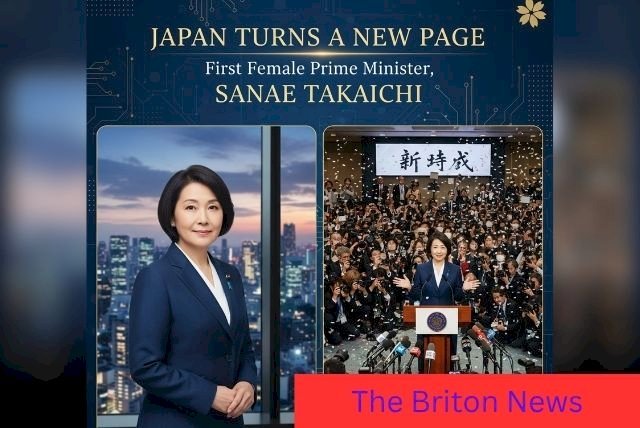Japan Turns a New Page with First Female Prime Minister, Sanae Takaichi
Japan elects Sanae Takaichi as its first female Prime Minister after a historic 2025 vote, confirmed by the Diet and Emperor. A new era begins for Japanese politics.

Japan has shattered a political glass ceiling — electing Sanae Takaichi as its first female Prime Minister — signaling both progress and conservatism in one stroke.
A Historic Day in Japanese Politics

Image source: pinterest.com
In a defining moment for modern Japan, Sanae Takaichi, 64, has become the nation’s first female Prime Minister, following a parliamentary vote on October 21, 2025.
The House of Representatives (Diet) confirmed her appointment with 237 votes out of 465, validating her as Japan’s 104th Prime Minister. Later that day, her appointment was formally endorsed by Emperor Naruhito, completing the constitutional process.
Takaichi succeeds Shigeru Ishiba, who resigned earlier this month after losing coalition support within the Liberal Democratic Party (LDP). Backed by the Japan Innovation Party (JIP) through an external support agreement, the LDP secured the parliamentary majority needed to form a government.
“I will serve Japan with calm strength and steady determination,” Takaichi said in her acceptance speech at the National Diet. “We stand at a turning point in our nation’s history — and I am ready to lead with responsibility.”
Why It Matters
Japan joins a global circle of nations — from Israel’s Golda Meir to Britain’s Margaret Thatcher and Italy’s Giorgia Meloni — that have seen women ascend to top leadership.
For a country where women hold only about 16% of parliamentary seats, and where Japan ranks 125th in the 2025 Global Gender Equality Index, Takaichi’s election marks both a symbolic victory and a societal mirror.
Her rise sends a message that even in Japan’s deeply traditional political culture, change — however cautious — is possible.
Breaking Barriers, Balancing Tradition
Born in Nara Prefecture in 1961, Sanae Takaichi studied economics at Kobe University and later attended UCLA in the United States, where she drew inspiration from conservative American leaders like Ronald Reagan and Margaret Thatcher.
She began her political career in the early 1990s and has since built a reputation as one of Japan’s most disciplined and detail-oriented lawmakers. Over three decades, she has served in several senior posts, including:
-
Minister of Internal Affairs and Communications (2014–2017, 2019–2021)
-
Minister for Economic Security (2022–2025)
-
Minister of State for Science and Technology Policy
Often described as “Japan’s Iron Lady,” Takaichi is admired for her methodical leadership style and unflinching confidence. Yet her appointment reflects not only persistence but strategic adaptability — her “moderate conservative repositioning” during the 2025 LDP leadership campaign helped her appeal to centrist factions and secure external support from the JIP.
A Conservative Who Evolves
Takaichi’s ideology remains grounded in conservative principles, but her tone has softened in recent months. She now emphasizes economic reform and innovation alongside her long-standing commitments to:
-
National security expansion, including defense spending over 2% of GDP.
-
Economic independence, with reduced reliance on Chinese imports and supply chains.
-
Education reform, focusing on patriotism and civic responsibility.
-
Fiscal discipline, supporting balanced budgets and corporate growth.
Still, her personal beliefs remain traditional: she opposes separate surnames for married couples and supports ceremonial respect for Japan’s wartime history — including occasional visits to the controversial Yasukuni Shrine.
Political sociologist Keiko Yamashita observed, “Takaichi’s win is about authority, not ideology — a triumph of strength over symbolism.”
The Coalition Equation
Takaichi’s rise was made possible by a delicate power-sharing arrangement. After the centrist Komeito Party withdrew from the coalition earlier this month, the Japan Innovation Party (JIP) agreed to extend external parliamentary support to the LDP.
While the JIP will not join the cabinet directly, this agreement ensures a stable majority for Takaichi’s administration — at least in the short term.
Her immediate challenges include:
-
Steering inflation control and household cost relief.
-
Overseeing tax reforms aimed at revitalizing small businesses.
-
Rebuilding public confidence in the LDP amid ongoing political funding scandals.
Economists note that stability itself is a victory.
“Markets prefer predictability, and Takaichi brings that,” said analyst Hiroshi Kawamura of Nomura Securities. “But the new PM must prove that continuity doesn’t mean stagnation.”
Market and Economic Reaction
Tokyo’s financial markets greeted the new leadership with modest optimism.
The Nikkei 225 Index rose by approximately 1.1% on the day of her appointment, while the yen gained slightly against the U.S. dollar.
The uptick reflects investor expectations that Takaichi’s government will pursue steady, pro-business policies and avoid abrupt fiscal changes.
However, structural challenges persist — including sluggish wage growth, labor shortages, and Japan’s dependency on imported energy.
Her administration’s early focus will likely include:
-
Strengthening energy security, particularly through LNG partnerships.
-
Expanding semiconductor independence under the Economic Security Act.
-
Encouraging foreign investment in digital industries.
Global Reactions: Warm Congratulations and Strategic Caution
India
Prime Minister Narendra Modi congratulated Takaichi, calling her win “a proud moment for Japanese democracy and a promising step for Indo-Pacific partnership.” Analysts expect a continued strengthening of India–Japan defense and technology ties.
United States
President Donald Trump, set to visit Tokyo later this month, described her as “a strong and reliable partner.” The White House released a statement praising Japan’s “commitment to shared security and free-market values.”
European Union
Brussels welcomed Takaichi’s leadership, highlighting Japan’s “role as a cornerstone of democratic resilience in Asia.”
China
Beijing’s tone was reserved. Foreign Ministry spokesperson Lin Jian expressed hope for “constructive dialogue,” while cautioning against “provocations concerning Taiwan and maritime security.”
Australia and ASEAN
Regional governments echoed optimism, viewing Takaichi’s administration as a symbol of stability in the Indo-Pacific.
Japan’s Iron Lady 2.0: Public Reactions
Public sentiment is largely positive but cautious.
A Yomiuri Shimbun poll conducted after the Diet vote found:
-
63% of Japanese citizens expressed pride in seeing a woman lead the country for the first time.
-
52% remain uncertain whether her policies will improve everyday life.
On social media, hashtags like #高市早苗 (Takaichi Sanae) and #日本初の女性総理 (Japan’s First Female PM) dominated X (formerly Twitter), with many younger voters calling the moment “historic but overdue.”
Columnist Naomi Takahashi summarized it best: “She’s breaking ceilings with one hand and holding tradition with the other.”
Next 100 Days: What to Watch
Briton News has compiled the major policy priorities and events shaping Takaichi’s early term:
| Timeline | Focus Areas |
|---|---|
| Late October 2025 | Cabinet formation: expected inclusion of reform-minded figures like Shinjiro Koizumi (Environment) and Yoshimasa Hayashi (Foreign Affairs). |
| November 2025 | Economic tax plan debate in the Diet; expected revisions to corporate tax incentives. |
| Late October 2025 | Visit from U.S. President Donald Trump; discussions on defense, trade, and technology. |
| December 2025 | Announcement of new education guidelines emphasizing innovation and moral literacy. |
| January 2026 | Defense and Security Council session outlining Japan’s updated Indo-Pacific strategy. |
These first 100 days will test Takaichi’s ability to translate symbolism into substance — balancing expectations at home and alliances abroad.
Her Personality: Steel Meets Soul
Beyond politics, Sanae Takaichi’s personal life has fascinated the public. A known heavy metal music enthusiast, she once played guitar in a college band. She also enjoys motorcycles, a passion she says helps her “clear her thoughts before big decisions.”
This blend of toughness and humanity adds relatability to her otherwise disciplined persona. Colleagues describe her as “methodical but approachable — the rare politician who listens before she speaks.”
At a Glance: Key Facts
| Name | Sanae Takaichi (高市 早苗) |
|---|---|
| Position | Prime Minister of Japan |
| Assumed Office | October 21, 2025 |
| Political Party | Liberal Democratic Party (LDP) |
| Coalition Support | Japan Innovation Party (external support) |
| Votes in Diet | 237 / 465 (House of Representatives) |
| Formally Endorsed By | Emperor Naruhito |
| Age | 64 |
| Born | Nara Prefecture, Japan |
| Education | Kobe University; UCLA (Exchange Studies) |
| Succeeded | Shigeru Ishiba |
| Political Stance | Moderate Conservative; Pro-defense; Economic Security Focus |
| Known For | “Iron Lady 2.0,” nationalist views, calm leadership style |
| Interests | Heavy metal music, motorcycles |
Briton News Analysis
Sanae Takaichi’s appointment captures Japan’s dual identity — a society deeply rooted in tradition yet yearning for renewal.
Her leadership marks a milestone for gender equality, but her policies remain anchored in conservative continuity. The challenge ahead lies in balancing symbolic change with substantive progress — revitalizing Japan’s economy, rebuilding public trust, and redefining its place in the Indo-Pacific.
If she succeeds, Takaichi could become not just Japan’s first female Prime Minister, but one of its most consequential leaders in decades.
“History will judge her not by her gender,” said former diplomat Yoshihisa Komori, “but by whether she can give Japan a new sense of purpose.”
Conclusion
As Sanae Takaichi steps into office, Japan enters an era that bridges history and modernity. Her rise to power represents progress in form and continuity in substance — a reflection of Japan’s cautious evolution.
Whether she leads Japan toward reform or reinforces its traditional core will depend on her next moves — and the next 100 days may tell the story.
For now, Japan has indeed turned a new page, and the world is watching how this chapter unfolds.
FAQs — Japan’s First Female Prime Minister: Sanae Takaichi (2025 Update)
1. Who is Sanae Takaichi?
Sanae Takaichi is a Japanese politician and the leader of the Liberal Democratic Party (LDP). On October 21, 2025, she made history by becoming Japan’s first female Prime Minister, known for her conservative views, focus on national security, and pragmatic leadership style.
2. When was Sanae Takaichi elected as Prime Minister?
She was elected by Japan’s parliament (Diet) on October 21, 2025, winning 237 out of 465 votes in the House of Representatives. Her appointment was formally approved by Emperor Naruhito the same day.
3. Which party does Sanae Takaichi belong to?
Sanae Takaichi belongs to the Liberal Democratic Party (LDP) — Japan’s ruling conservative party that has governed most of the post-war period.
4. Who did Sanae Takaichi replace as Prime Minister?
She succeeded Shigeru Ishiba, who resigned in early October 2025 after losing coalition support within the ruling LDP.
5. What coalition supports Sanae Takaichi’s government?
Takaichi leads the LDP government with external support from the Japan Innovation Party (JIP). The JIP is not part of her cabinet, but it provides parliamentary backing after the Komeito Party withdrew from the coalition earlier in October 2025.
6. Why is Sanae Takaichi’s election historic?
Her election marks the first time Japan has chosen a female Prime Minister, breaking a 77-year precedent of male-only leadership. With women holding only 16% of parliamentary seats, it represents a major step forward for gender representation in Japan’s politics.
7. What are Sanae Takaichi’s main policies?
Her top priorities include:
-
Strengthening national defense and security
-
Boosting economic self-reliance and semiconductor independence
-
Promoting energy security and stable supply chains
-
Continuing parts of Abenomics with a focus on innovation
-
Upholding traditional family and cultural values
8. What are her views on women’s rights and feminism?
Despite being Japan’s first female Prime Minister, Takaichi is not considered a feminist reformer. She supports traditional gender roles and has opposed policies such as allowing married couples to use separate surnames. Analysts describe her leadership as symbolic progress without ideological shift.
9. How did world leaders react to her appointment?
Global reactions were broadly positive:
-
India’s PM Narendra Modi congratulated her and highlighted stronger Indo-Pacific ties.
-
U.S. President Donald Trump called her “a decisive and dependable partner.”
-
EU leaders welcomed her leadership for stability.
-
China reacted cautiously, urging “peaceful cooperation in the region.”
10. How did Japan’s stock market react to her election?
The Nikkei 225 index rose by about 1.1% after her appointment, reflecting investor confidence in her steady economic policies and continuity in governance.
11. What challenges will Sanae Takaichi face as Prime Minister?
Her key challenges include:
-
Managing economic slowdown and inflation
-
Addressing public distrust in the LDP after funding scandals
-
Handling China–Taiwan tensions and defense expansion
-
Balancing traditional values with modern reforms
12. What is Japan’s gender equality ranking in 2025?
According to the World Economic Forum’s Global Gender Gap Report 2025, Japan ranks 125th out of 146 countries for gender equality — one of the lowest among developed nations.
13. What will be the focus of Sanae Takaichi’s first 100 days?
Her first 100 days will center on:
-
Forming a balanced cabinet with reformist figures like Shinjiro Koizumi
-
Presenting her economic tax plan to boost growth
-
Meeting U.S. President Donald Trump during his Asia visit
-
Announcing education and defense reform policies before year-end
14. How does Sanae Takaichi compare to Shinzo Abe?
Takaichi is often seen as Shinzo Abe’s ideological successor. Like Abe, she supports constitutional reform to strengthen Japan’s Self-Defense Forces but also emphasizes economic independence, innovation, and global diplomacy.
15. Why is Sanae Takaichi called “Japan’s Iron Lady 2.0”?
She earned the nickname “Iron Lady 2.0” for her firm, strategic leadership and admiration for Britain’s Margaret Thatcher. Her mix of conservative policy, discipline, and resilience mirrors Thatcher’s political style — modernized for Japan’s 21st-century challenges.














